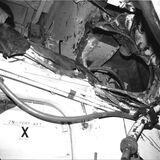Half a world, and half a lifetime away.
Discussion
12th June
42 Cdo took Mount Harriet, losing one Marine killed and a dozen wounded. They then turned their attention to the next hilltop on the road to Port Stanley, Mount Tumbledown, which had been subjected to bombardment from HMS Yarmouth. This was the subject of the 1988 film starring Colin Firth as Lt. Robert Lawrence, MC.
3 Para, supported by HMS Avenger, was tasked with interdicting the Argentine supply route to Mount Longdon and shelling their supporting positions on Wireless Ridge. The first lines of the Mount Longdon defence were taken but the Paras then encountered strong resistance. The 105mm guns of 29 Cdo and Avenger’s 4.5in gun subdued the defenders but the frigate had to curtail her bombardment after firing 156 rounds. 3 Para sustained the heaviest casualties in any land attack; eighteen men were killed and thirty-nine wounded.
45 Cdo began to move forward on Two Sisters after the battle on Mount Longdon had begun, but approached in silence and were not detected until they were within 500 yards of the nearest peak. The Marines pressed their advance covered by supporting fire from Glamorgan and Avenger and Two Sisters was taken by the early morning.
HMS Glamorgan and Yarmouth withdrew, leaving Avenger on the gunline to continue support for 3 Para. About seventeen miles south-west of Port Stanley, Glamorgan detected an approaching radar contact - an Exocet fired from a truck on a road behind Port Harriet. HMS Glamorgan was hit and seriously damaged, with thirteen killed and many injured.
HMS Arrow returned to the Carrier Battle Group before dawn, having spent the night bombarding the Sapper Hill, racecourse and airfield areas.
At first light the helicopters resumed their shuttle runs.
MV [i]Norland]/i] landed 1,016 Argentine passengers at Montevideo.
Exeter was replaced in the Transport Area by HMS Cardiff.
SD.
42 Cdo took Mount Harriet, losing one Marine killed and a dozen wounded. They then turned their attention to the next hilltop on the road to Port Stanley, Mount Tumbledown, which had been subjected to bombardment from HMS Yarmouth. This was the subject of the 1988 film starring Colin Firth as Lt. Robert Lawrence, MC.
3 Para, supported by HMS Avenger, was tasked with interdicting the Argentine supply route to Mount Longdon and shelling their supporting positions on Wireless Ridge. The first lines of the Mount Longdon defence were taken but the Paras then encountered strong resistance. The 105mm guns of 29 Cdo and Avenger’s 4.5in gun subdued the defenders but the frigate had to curtail her bombardment after firing 156 rounds. 3 Para sustained the heaviest casualties in any land attack; eighteen men were killed and thirty-nine wounded.
45 Cdo began to move forward on Two Sisters after the battle on Mount Longdon had begun, but approached in silence and were not detected until they were within 500 yards of the nearest peak. The Marines pressed their advance covered by supporting fire from Glamorgan and Avenger and Two Sisters was taken by the early morning.
HMS Glamorgan and Yarmouth withdrew, leaving Avenger on the gunline to continue support for 3 Para. About seventeen miles south-west of Port Stanley, Glamorgan detected an approaching radar contact - an Exocet fired from a truck on a road behind Port Harriet. HMS Glamorgan was hit and seriously damaged, with thirteen killed and many injured.
HMS Arrow returned to the Carrier Battle Group before dawn, having spent the night bombarding the Sapper Hill, racecourse and airfield areas.
At first light the helicopters resumed their shuttle runs.
MV [i]Norland]/i] landed 1,016 Argentine passengers at Montevideo.
Exeter was replaced in the Transport Area by HMS Cardiff.
SD.
HMS Glamorgan – 12th June
HMS Glamorgan (D19) was a County-class destroyer, built by Vickers Armstrong in Newcastle Upon Tyne. With a displacement of 5,440 tonnes, she was launched on June 9, 1964, and was delivered to the Navy two years later. In the mid- 1970s Glamorgan had her 'B' turret replaced by four Exocet launchers.
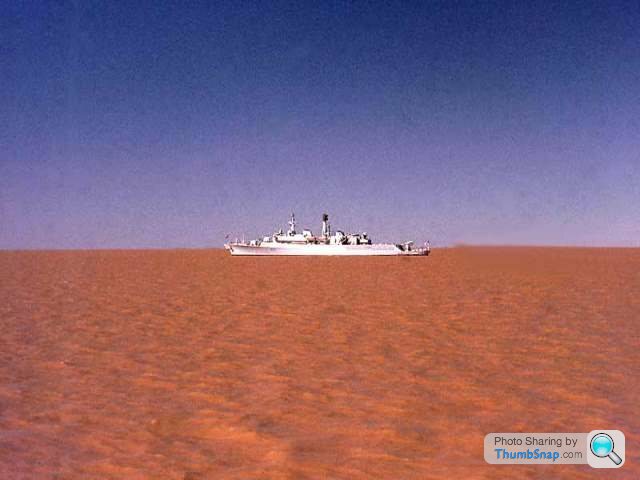
HMS Glamorgan 1972.
The picture above was taken when she was in the South Atlantic, seen here off the River Plate - the red colour is scoured mud colouring the ocean up to 50 miles off shore. Note the 'B' turret still in situ.
She spent many months in late 1982 being refitted, and was back at sea in 1983. Her last active deployment for the Royal Navy was to the coast of Lebanon, assisting British peace-keeping troops there in 1984.
At the start of the Falklands campaign, Glamorgan was already at sea off Gibraltar about to take part in exercises; she was immediately diverted to join the main Royal Navy task force, and served as flagship for Admiral Sandy Woodward during the voyage south. Her most useful armament proved to be her remaining twin 4.5 inch guns, which were used primarily to bombard enemy positions on shore.
Glamorgan was first in action on the evening and night of 1 May when she joined forces with HMS Arrow and HMS Alacrity to bombard Argentine positions around Port Stanley. The three British ships soon came under attack by Mirage III jets with two 500 lb bombs falling close alongside Glamorgan and causing minor underwater damage.
Two weeks later on 14 May she was again in action, this time supporting British special forces on Pebble Island (West Falkland), and for the next two weeks until the end of May she was almost continuously engaged bombarding various shore positions on the east of the islands mainly as part of a plan to distract attention from the landings at San Carlos, but also against the airfield at Port Stanley and in support of British forces ashore. She twice survived unsuccessful Exocet attacks.
At the beginning of June, the task force having been reinforced with other ships, Glamorgan was detached to protect shipping in the Tug and Logistics Repair Area (TARLA), some 200 miles away from the islands, but as the campaign reached a climax she was recalled in the evening of 11 June to support the Royal Marines fighting the Battle of Two Sisters.
At 06:37 the following morning, following an intense but unsuccessful air raid, she was struck by an Exocet missile fired from a shore-based launcher improvised on the back of a lorry trailer.
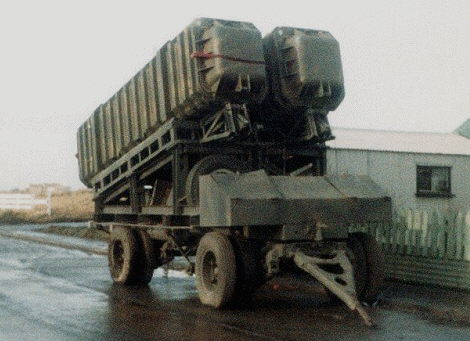
The improvised Exocet launcher.
Glamorgan was some 18 miles off shore at the time and steaming at about 20 knots. Her radar systems failed to detect the incoming missile (which was smaller and faster than anything they had been designed for), so the only warning was a visual contact.
Fortunately, the ship was moving fast enough to be able to turn rapidly away from the missile in the few seconds available, and the missile struck her port side towards the stern. Instead of penetrating the ship's side at right angles (as it was designed to do), it hit the angle of the deck coaming and ricocheted into the hangar, causing the Wessex helicopter to explode and starting a severe fire both in the hangar and in the main galley immediately below.

Showing damage – all fires extinguished.
In all thirteen crew members were killed, and a number wounded. The ship was underway again with all fires extinguished by 10:00.
On the following day, repairs were made at sea, and after the Argentinian surrender on 14 June, more extensive repairs were undertaken in the sheltered waters of San Carlos Bay. She sailed for home on 21 June, and re-entered Portsmouth on 10 July 1982 after 104 days at sea.
Roll of Honour - HMS Glamorgan.
SD.
HMS Glamorgan (D19) was a County-class destroyer, built by Vickers Armstrong in Newcastle Upon Tyne. With a displacement of 5,440 tonnes, she was launched on June 9, 1964, and was delivered to the Navy two years later. In the mid- 1970s Glamorgan had her 'B' turret replaced by four Exocet launchers.

HMS Glamorgan 1972.
The picture above was taken when she was in the South Atlantic, seen here off the River Plate - the red colour is scoured mud colouring the ocean up to 50 miles off shore. Note the 'B' turret still in situ.
She spent many months in late 1982 being refitted, and was back at sea in 1983. Her last active deployment for the Royal Navy was to the coast of Lebanon, assisting British peace-keeping troops there in 1984.
At the start of the Falklands campaign, Glamorgan was already at sea off Gibraltar about to take part in exercises; she was immediately diverted to join the main Royal Navy task force, and served as flagship for Admiral Sandy Woodward during the voyage south. Her most useful armament proved to be her remaining twin 4.5 inch guns, which were used primarily to bombard enemy positions on shore.
Glamorgan was first in action on the evening and night of 1 May when she joined forces with HMS Arrow and HMS Alacrity to bombard Argentine positions around Port Stanley. The three British ships soon came under attack by Mirage III jets with two 500 lb bombs falling close alongside Glamorgan and causing minor underwater damage.
Two weeks later on 14 May she was again in action, this time supporting British special forces on Pebble Island (West Falkland), and for the next two weeks until the end of May she was almost continuously engaged bombarding various shore positions on the east of the islands mainly as part of a plan to distract attention from the landings at San Carlos, but also against the airfield at Port Stanley and in support of British forces ashore. She twice survived unsuccessful Exocet attacks.
At the beginning of June, the task force having been reinforced with other ships, Glamorgan was detached to protect shipping in the Tug and Logistics Repair Area (TARLA), some 200 miles away from the islands, but as the campaign reached a climax she was recalled in the evening of 11 June to support the Royal Marines fighting the Battle of Two Sisters.
At 06:37 the following morning, following an intense but unsuccessful air raid, she was struck by an Exocet missile fired from a shore-based launcher improvised on the back of a lorry trailer.

The improvised Exocet launcher.
Glamorgan was some 18 miles off shore at the time and steaming at about 20 knots. Her radar systems failed to detect the incoming missile (which was smaller and faster than anything they had been designed for), so the only warning was a visual contact.
Fortunately, the ship was moving fast enough to be able to turn rapidly away from the missile in the few seconds available, and the missile struck her port side towards the stern. Instead of penetrating the ship's side at right angles (as it was designed to do), it hit the angle of the deck coaming and ricocheted into the hangar, causing the Wessex helicopter to explode and starting a severe fire both in the hangar and in the main galley immediately below.

Showing damage – all fires extinguished.
In all thirteen crew members were killed, and a number wounded. The ship was underway again with all fires extinguished by 10:00.
On the following day, repairs were made at sea, and after the Argentinian surrender on 14 June, more extensive repairs were undertaken in the sheltered waters of San Carlos Bay. She sailed for home on 21 June, and re-entered Portsmouth on 10 July 1982 after 104 days at sea.
Roll of Honour - HMS Glamorgan.
- Lieutenant David H. R. Tinker
- Petty Officer Michael J. Adcock
- Petty Officer Colin P. Vickers
- Cook Brian Easton
- Air Engineering Mechanician Mark Henderson
- Air Engineering Mechanician Brian P. Hinge
- Acting Chief Air Engineering Mechanician David Lee
- Air Engineering Artificer Kelvin I. McCallum
- Cook Brian J. Malcolm
- Marine Engineering Mechanic Terence W. Perkins
- Leading Cook Mark A. Sambles
- Leading Cook Anthony E. Sillence
- Steward John D. Stroud
SD.
louiechevy said:
If any of you are interested I've managed to find the old 1982 videos of the BBC documentary task force south and managed to transfer the first four episodes onto a DVD and will try to upload them to YouTube! That may be the hard part  But If I can I will post a link here if that's OK with SD.
But If I can I will post a link here if that's OK with SD.
Yes please. But If I can I will post a link here if that's OK with SD.
But If I can I will post a link here if that's OK with SD.SD.
13th June
The Battles for Tumbledown, Wireless Ridge and Mount William - 15 Britons and 40 Argentines die.
HMS Active and Arrow harassed positions on Sapper Hill and Moody Brook and returned to the Battle Group after sunrise.
The Stena Seaspread finished repairs to the Plymouth, who then rejoined the Battle Group. She was replaced by HMS Glamorgan.
Helicopters continued supply sorties despite snow showers reducing visibility.
Mid-morning, an 801 Squadron CAP sighted an Argentine patrol craft. It was thought to be the Rio Iguazu, driven aground on May 22nd, the Harriers received permission to strafe the vessel.
Seven A-4Bs made for the 3 Cdo Brigade Tactical HQ. Brigadier Thompson had gathered his unit commanders for on 'Operations Group' briefing. Few of the bombs exploded but some landed too close for the commanders' comfort.
HMS Cardiff's Lynx was carrying out the routine forenoon clearance search to the south of the Falkland Sound, when it was attacked by three Daggers, the helicopter crews evasive action prevented the aircraft being damaged.
A pair of GR3s flew from Hermes to deliver a laser-guided bomb attack on the Argentine artillery in the Moody Brook area.
The hospital ship Almirante Irizar, arrived with a team from the ICRC. A 'Red Cross Zone' was established around the Cathedral.
The Rio Iguaz was strafed once again by an 801 Sqn CAP and HMS Penelope's Lynx hit it with a Sea Skua before dusk.
In the late evening, HMS Cardiff detected the first of a number of aircraft coming in from the west, toward HMS Intrepid. It was joined by another two aircraft which proceeded to fly on towards Fitzroy and Port Stanley. When the lead contact was in Sea Dart range, the destroyer fired a single missile. The missile hit the lead Canberra and although the pilot ejected, the navigator failed to escape.
Two further aircraft kept coming. HMS Penelope saw a bright glow and a trail heading toward her and her charge - the Nordic Ferry. Penelope took evasive action, firing chaff to screen herself and the Nordic Ferry and opened fire with both Seacat and Bofors as the missile closed. It ditched about 1,000 yards between the two ships.
SD.
The Battles for Tumbledown, Wireless Ridge and Mount William - 15 Britons and 40 Argentines die.
HMS Active and Arrow harassed positions on Sapper Hill and Moody Brook and returned to the Battle Group after sunrise.
The Stena Seaspread finished repairs to the Plymouth, who then rejoined the Battle Group. She was replaced by HMS Glamorgan.
Helicopters continued supply sorties despite snow showers reducing visibility.
Mid-morning, an 801 Squadron CAP sighted an Argentine patrol craft. It was thought to be the Rio Iguazu, driven aground on May 22nd, the Harriers received permission to strafe the vessel.
Seven A-4Bs made for the 3 Cdo Brigade Tactical HQ. Brigadier Thompson had gathered his unit commanders for on 'Operations Group' briefing. Few of the bombs exploded but some landed too close for the commanders' comfort.
HMS Cardiff's Lynx was carrying out the routine forenoon clearance search to the south of the Falkland Sound, when it was attacked by three Daggers, the helicopter crews evasive action prevented the aircraft being damaged.
A pair of GR3s flew from Hermes to deliver a laser-guided bomb attack on the Argentine artillery in the Moody Brook area.
The hospital ship Almirante Irizar, arrived with a team from the ICRC. A 'Red Cross Zone' was established around the Cathedral.
The Rio Iguaz was strafed once again by an 801 Sqn CAP and HMS Penelope's Lynx hit it with a Sea Skua before dusk.
In the late evening, HMS Cardiff detected the first of a number of aircraft coming in from the west, toward HMS Intrepid. It was joined by another two aircraft which proceeded to fly on towards Fitzroy and Port Stanley. When the lead contact was in Sea Dart range, the destroyer fired a single missile. The missile hit the lead Canberra and although the pilot ejected, the navigator failed to escape.
Two further aircraft kept coming. HMS Penelope saw a bright glow and a trail heading toward her and her charge - the Nordic Ferry. Penelope took evasive action, firing chaff to screen herself and the Nordic Ferry and opened fire with both Seacat and Bofors as the missile closed. It ditched about 1,000 yards between the two ships.
SD.
14th June
The infantry attacks were preceded by an artillery and mortar barrage and was accompanied by bombardments by two frigates.
2 Para drove the enemy from the northern part of Wireless Ridge, supported by bombardments from HMS Yarmouth and Ambuscade, then moved ahead to meet up with troops who had begun an advance from the easterly peninsula. They were supported by the light tanks of the Blues and Royals.
The Scots Guards advanced on Mount Tumbledown with support provided by HMS Active. The defenders outnumbered the Scots Guards and brought the advance to a halt while the Royal Artillery, the infantry's mortars and HMS Active and Avenger bombarded the ridge.
The frigates left Berkley Sound before dawn.
A mixed Army/Royal Marine Scout formation rendezvoused behind Wireless Ridge in the dawn light. The three helicopters were each fitted with wire-guided missiles and made two passes over the ridge to fire on defensive bunkers scoring three direct hits on 105mm gun pits.
The Gurkhas came around the flank of the Argentine marines holding Mount Tumbledown and the defenders finally broke. The Gurkhas moved on to take Mount William. The high ground was now in British hands.
GR3s from the Hermes delivered a laser-guided bomb strike on a battery covering the marines' pull-back from Tumbledown.
By now the only eminence in Argentine hands was Sapper Hill, located a little to the west of Port Stanley.
Naval transport helicopters flew Alfa and Charlie Companies of 40 Cdo forward to Sapper Hill. The first troop were dropped too close to the enemy and two Marines were wounded. As the troops were set down, they were ordered to cease fire. The Argentine Army was negotiating a cease-fire.
By 11.30am 2 Para were in Port Stanley, 40 Cdo overlooking it from Sapper Hill with orders to fire only in self-defence.
The Battle Group learned of the cease-fire via one of the GR3 pilots, who was instructed to hold off from a laser-guided bomb attack and sent back to Hermes with the news that white flags had been seen over Port Stanley.
HMS Plymouth and Yarmouth detached to proceed to Berkley Sound in the afternoon to provide supports in the event of the negotiations breaking down.
One of the 820 Sqn Sea Kings took General Moore from the Fearless to Port Stanley where at midnight Greenwich Mean Time, General Menedez and General Moore signed the formal instrument of surrender.
General Mario Menendez surrenders to Major General Jeremy Moore at 9pm FI time.
9,800 Argentine troops put down their arms.
Thatcher informs the Commons at 10.15pm UK time that the Argentines have surrendered.
I'll get some video, audio and pictures up later. Also to follow is a full roll of honour, I'm just waiting on some names from the Argentinian side..
SD.
The infantry attacks were preceded by an artillery and mortar barrage and was accompanied by bombardments by two frigates.
2 Para drove the enemy from the northern part of Wireless Ridge, supported by bombardments from HMS Yarmouth and Ambuscade, then moved ahead to meet up with troops who had begun an advance from the easterly peninsula. They were supported by the light tanks of the Blues and Royals.
The Scots Guards advanced on Mount Tumbledown with support provided by HMS Active. The defenders outnumbered the Scots Guards and brought the advance to a halt while the Royal Artillery, the infantry's mortars and HMS Active and Avenger bombarded the ridge.
The frigates left Berkley Sound before dawn.
A mixed Army/Royal Marine Scout formation rendezvoused behind Wireless Ridge in the dawn light. The three helicopters were each fitted with wire-guided missiles and made two passes over the ridge to fire on defensive bunkers scoring three direct hits on 105mm gun pits.
The Gurkhas came around the flank of the Argentine marines holding Mount Tumbledown and the defenders finally broke. The Gurkhas moved on to take Mount William. The high ground was now in British hands.
GR3s from the Hermes delivered a laser-guided bomb strike on a battery covering the marines' pull-back from Tumbledown.
By now the only eminence in Argentine hands was Sapper Hill, located a little to the west of Port Stanley.
Naval transport helicopters flew Alfa and Charlie Companies of 40 Cdo forward to Sapper Hill. The first troop were dropped too close to the enemy and two Marines were wounded. As the troops were set down, they were ordered to cease fire. The Argentine Army was negotiating a cease-fire.
By 11.30am 2 Para were in Port Stanley, 40 Cdo overlooking it from Sapper Hill with orders to fire only in self-defence.
The Battle Group learned of the cease-fire via one of the GR3 pilots, who was instructed to hold off from a laser-guided bomb attack and sent back to Hermes with the news that white flags had been seen over Port Stanley.
First Reports said:
They are reported to be flying white flags over Port Stanley.
Admiral Woodward was aware that the negotiations concerned only the Argentine forces on the islands and warned his ships, Admiral Woodward said:
Our guard must not be reduced but we must not jeopardize results so far achieved …. ARG air threat (overland) remains and must be countered. The threat at sea has not changed.'
CAPs continued to fly through the day.HMS Plymouth and Yarmouth detached to proceed to Berkley Sound in the afternoon to provide supports in the event of the negotiations breaking down.
One of the 820 Sqn Sea Kings took General Moore from the Fearless to Port Stanley where at midnight Greenwich Mean Time, General Menedez and General Moore signed the formal instrument of surrender.
General Mario Menendez surrenders to Major General Jeremy Moore at 9pm FI time.
9,800 Argentine troops put down their arms.
Thatcher informs the Commons at 10.15pm UK time that the Argentines have surrendered.
I'll get some video, audio and pictures up later. Also to follow is a full roll of honour, I'm just waiting on some names from the Argentinian side..
SD.
Some of the ephemera from the period - pictures, newspaper headlines and other media is largely forgotten until the memory is jogged. Some of the more famous headlines came at the beginning of the conflict show the general feeling of the country at the time. This was going to be an absolute walkover.
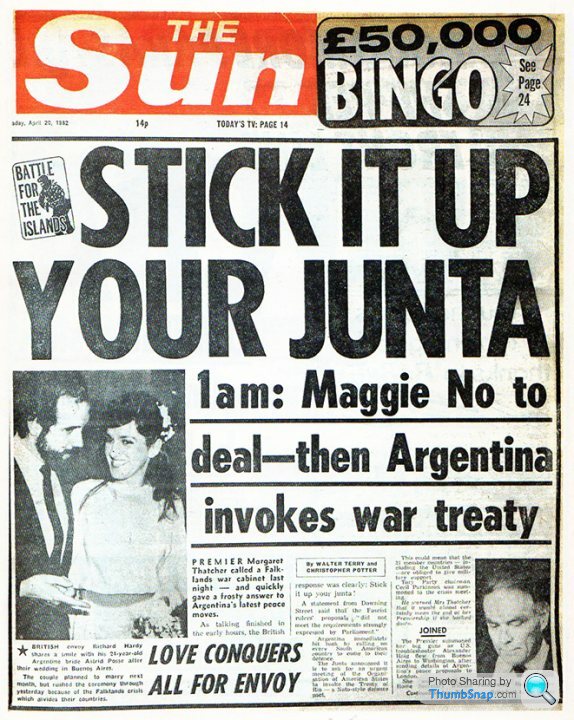
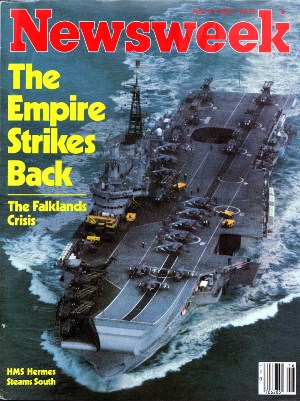
The conflict was never universally supported in this country - and one of the most controversial incidents - the sinking of ARA Belgrano gave us some of the most powerful moments.
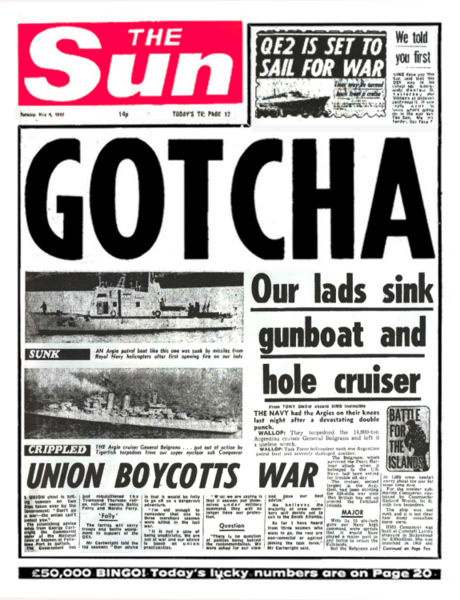
As well as a famous interview with Margaret Thatcher.
https://youtu.be/AsQ0THsRPBQ
The losses by the Royal Navy gave the country a massive reality check. Sheffield, Coventry, Ardent, Antelope and all the others - names that at the time were all over the news, the only topic of conversation are now nothing but memories. This was the first modern Air versus Naval conflict and one important lesson was reinforced. "Planes kick boat ass."
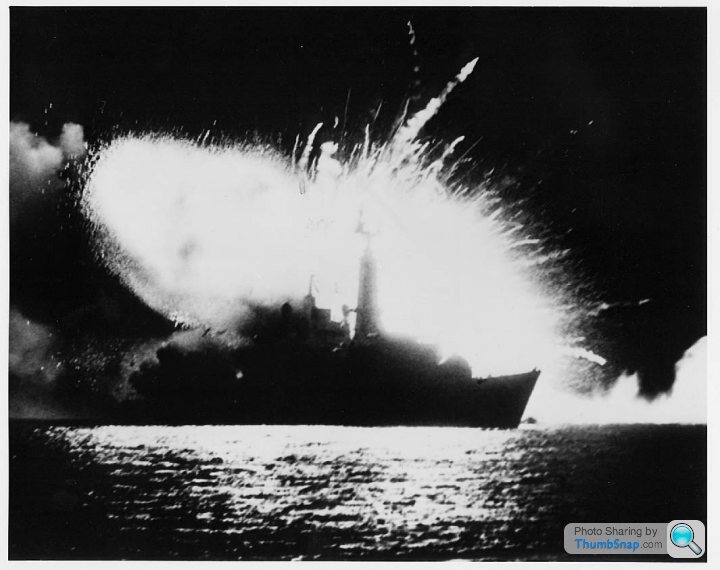
The general description of the average Argentinean service man was one of a cold, shivering conscript who was unwilling to fight. Some of the pictures show dispirited young men.

As well as large amounts of abandoned weapons and equipment.
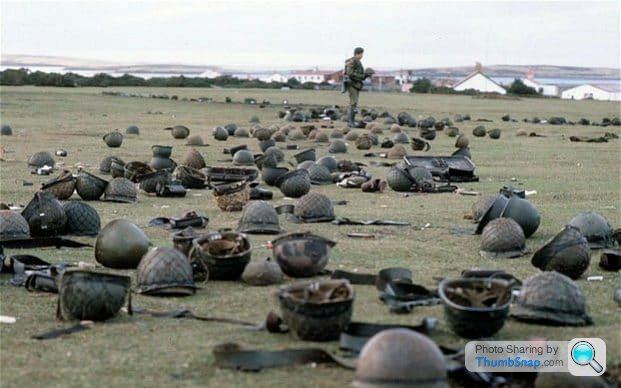
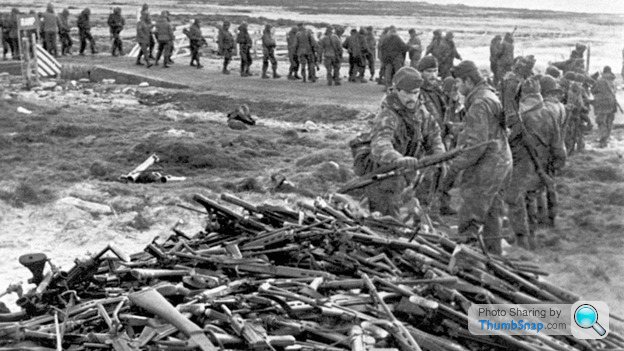
The reality was that many of the servicemen on both sides were young, frightened and cold. Professionalism and better training may have been one of the deciding factors.
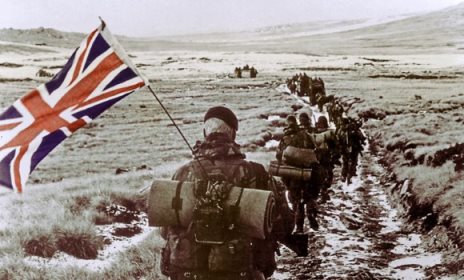
After the final battles of the night of 13/14th June the surrender was negotiated and a ceasefire was called.
https://1drv.ms/b/s!Ane9lOTY5nFrrwBpJVGzNiBUJY0I
https://1drv.ms/b/s!Ane9lOTY5nFrrwEGeIQRjFItKxz_
This video, I think, sums up the conflict. (Warning, it may get a little dusty.)
Several years ago I was sent a recording of a piece of prose - it laments the diminution of the RN, once the largest Navy in the world, now with less vessels than CalMac ferries.
http://s000.tinyupload.com/index.php?file_id=08064...
It's been an honour to compile this timeline, all that remains is to publish the lists of the fallen on both sides. As soon as I have all the names of the Argentinean dead I will post them together, Brothers in Arms.
SD.


The conflict was never universally supported in this country - and one of the most controversial incidents - the sinking of ARA Belgrano gave us some of the most powerful moments.

As well as a famous interview with Margaret Thatcher.
https://youtu.be/AsQ0THsRPBQ
The losses by the Royal Navy gave the country a massive reality check. Sheffield, Coventry, Ardent, Antelope and all the others - names that at the time were all over the news, the only topic of conversation are now nothing but memories. This was the first modern Air versus Naval conflict and one important lesson was reinforced. "Planes kick boat ass."

The general description of the average Argentinean service man was one of a cold, shivering conscript who was unwilling to fight. Some of the pictures show dispirited young men.

As well as large amounts of abandoned weapons and equipment.


The reality was that many of the servicemen on both sides were young, frightened and cold. Professionalism and better training may have been one of the deciding factors.

After the final battles of the night of 13/14th June the surrender was negotiated and a ceasefire was called.
https://1drv.ms/b/s!Ane9lOTY5nFrrwBpJVGzNiBUJY0I
https://1drv.ms/b/s!Ane9lOTY5nFrrwEGeIQRjFItKxz_
This video, I think, sums up the conflict. (Warning, it may get a little dusty.)
Several years ago I was sent a recording of a piece of prose - it laments the diminution of the RN, once the largest Navy in the world, now with less vessels than CalMac ferries.
http://s000.tinyupload.com/index.php?file_id=08064...
It's been an honour to compile this timeline, all that remains is to publish the lists of the fallen on both sides. As soon as I have all the names of the Argentinean dead I will post them together, Brothers in Arms.
SD.
At the moment I am unable to complete the list of the Argentinean war dead - I'm waiting on the Defence Attache from the Argentine embassy to finish compiling the list - during the thread I have always tried to get the views of both sides using personal diaries etc that were freely sent to me many years ago. Sadly the lists of enemy combatants are not in any central published lists that I can find online.
The British (and civilian) deaths. Be aware that this list also contains members of the RFA, the Merchant Marine as well as civilian contractors such as laundry men serving on RN vessels.
Royal Navy
HMS Coventry
MEM(M)1 F O ARMES
ACWEA J D L CADDY
MEM(M)l P B CALLUS
APOCA S R DAWSON
AWEM(R)1 J K DOBSON
PO(S) M G FOWLER
WEM(O)1 I P HALL
LT R R HEATH
AWEM(N)1 D J A OZBIRN
LT CDR G S ROBINSON-MOLTKE
LRO(W) B J STILL
MEA2 G L J STOCKWELL
AWEAl D A STRICKLAND
AAB(EW) A D SUNDERLAND
MEM(M)2 S TONKIN
ACK I E TURNBULL
AWEA2 P P WHITE
WEA/APP I R WILLIAMS
HMS Glamorgan
POAEM(L) M J ADCOCK
CK B EASTON
AEM(M) M HENDERSON
AEM(R)1 B P HINGE
LACAEMN D LEE
AEA(M)2 K I McCALLUM
CK B J MALCOLM
MEM(M)2 T W PERKINS
L/CK M SAMBLES
L/CK A E SILLENCE
STD J D STROUD
LT D H R TINKER
POACMN C P VICKERS
HMS Ardent
AB(S) D D ARMSTRONG
LT CDR R W BANFIELD
AB(S) A R BARR
POAEM(M) P BROUARD
CK R J S DUNKERLEY
ALCK M P FOOTE
MEM(M)2 S H FORD
ASTD S HANSON
AB(S) S K HAYWARD
AB(EW) S HEYES
WEM(R)1 S J LAWSON
MEM(M)2 A R LEIGHTON
AEMN(I) A McAULEY
ALS(R) M S MULLEN
LT B MURPHY
LPT G T NELSON
APOWEM(R) A K PALMER
CK J R ROBERTS
LT CDR J M SEPHTON
ALMEM(M) S J WHITE
ALMEM(L) G WHITFORD
MEM(M)1 G S WILLIAMS
HMS Sheffield
LT CDR D I BALFOUR
POMEM(M) D R BRIGGS
CA D COPE
WEAl A C EGGINGTON
S/LT R C EMLY
POCK R FAGAN
CK N A GOODALL
LMEM(M) A J KNOWLES
LCK A MARSHALL
POWEM A R NORMAN
CK D E OSBORNE
WEA1 K R F SULLIVAN
CK A C SWALLOW
ACWEMN M TILL
WEMN2 B J WALLIS
LCK A K WELLSTEAD
MAA B WELSH
CK K J WILLIAMS
LT CDR J S WOODHEAD
HMS Hermes
LT CDR G W J BATT
POACMN K S CASEY
LT N TAYLOR
HMS Invincible
LT W A CURTIS
LT CDR J E EYTON-JONES
NA(AH)1 B MARSDEN
HMS Fearless
MEA(P) A S JAMES
ALMEM(M) D MILLER
HMS Argonaut
AB(R) I M BOLDY
S(M) M J STUART
HMS Antelope
STD M R STEPHENS
Atlantic Conveyor
AEM(R)1 A U ANSLOW
CPOWTR E FLANAGAN
LAEM(L) D L PRYCE
Royal Marines
CPL J G BROWNING
MNE P D CALLAN
MNE C DAVISON
SGT R ENEFER
SGT A P EVANS
CPL K EVANS
CPL P R FITTON
LT K D FRANCIS
L/CPL B P GIFFIN
MNE R D GRIFFIN
A/SGT I N HUNT
C/SGT B R JOHNSTON
SGT R A LEEMING
CPL M D LOVE
MNE S G McANDREWS
MNE G C MacPHERSON
L/CPL P B McKAY
MNE M J NOWAK
LT R J NUNN
MNE K PHILLIPS
SGT R J ROTHERHAM
MNE A J RUNDLE
CPL J SMITH
CPL I F SPENCER
CPL A B UREN
CPL L G WATTS
MNE D WILSON
Army
Welsh Guards
L/CPL A BURKE
L/SGT J R CARLYLE
GDSM I A DALE
GDSM M J DUNPHY
GDSM P EDWARDS
SGT C ELLEY
GDSM M GIBBY
GDSM G C GRACE
GDSM P GREEN
GDSM G M GRIFFITHS
GDSM D N HUGHES
GDSM G HUGHES
GDSM B JASPER
GDSM A KEEBLE
L/SGT K KEOGHANE
GDSM M J MARKS
GDSM C MORDECAI
L/CPL S J NEWBURY
GDSM G D NICHOLSON
GDSM C C PARSONS
GDSM E J PHILLIPS
GDSM G W POOLE
GDSM N A ROWBERRY
L/CPL P A SWEET
GDSM C C THOMAS
GDSM G K THOMAS
L/CPL N D M THOMAS
GDSM R G THOMAS
GDSM A WALKER
L/CPL C F WARD
GDSM J F WEAVER
SGT M WIGLEY
GDSM D R WILLIAMS
Scots Guards
GDSM D J DENHOLM
GDSM D MALCOLMSON
L/SGT C MITCHELL
GDSM J B C REYNOLDS
SGT J SIMEON
GDSM A G STIRLING
GDSM R TANBINI
WO11 D WIGHT
Army Air Corps
L/CPL S J COCKTON
S/SGT C A GRIFFIN
Royal Signals
S/SGT J I BAKER
MAJOR M L FORGE
CPL D F McCORMACK
Royal Electrical and Mechanical Engineers
CFN M W ROLLINS
CFN A SHAW
L/CPL A R STREATFIELD
Royal Engineers
SPR P K GHANDI
SPR C A JONES
CPL A G McIIVENNY
CPL M MELIA
L/CPL J B PASHLEY
S/SGT J PRESCOTT
SPR W D TARBARD
CPL S WILSON
Army Catering Corps
L/CPL B C BULLERS
PTE A M CONNETT
PTE M A JONES
PTE P W MIDDLEWICK
Royal Army Medical Corps
L/CPL I R FARRELL
MAJOR R NUTBEEM
PTE K PRESTON
Gurkha Rifles
L/CPL BUDHAPARSAD LIMBU
2 Para
LT J A BARRY
L/CPL G D BINGLEY
L/CPL A CORK
CAPTAIN C DENT
PTE S J DIXON
C/SGT G P M FINDLAY
PTE M W FLETCHER
CPL D HARDMAN
PTE M HOLMAN-SMITH
PTE S ILLINGSWORTH
LT COL H JONES
PTE T MECHAN
PTE D A PARR
CPL S R PRIOR
PTE F SLOUGH
L/CPL N R SMITH
CPL P S SULLIVAN
CAPTAIN D A WOOD
3 Para
PTE R J ABSOLON
PTE G BULL
PTE J S BURT
PTE J D CROW
PTE M S DODSWORTH
PTE A D GREENWOOD
PTE N GROSE
PTE P J HEDICKER
L/CPL P D HIGGS
CPL S HOPE
PTE T R JENKINS
PTE C D JONES
PTE S I LAING
L/CPL C K LOVETT
CPL S P F McLAUGHLIN
CPL K J McCARTHY
C/SGT I J McKAY
L/CPL J H MURDOCH
L/CPL D E SCOTT
PTE I P SCRIVENS
PTE P A WEST
SAS Regiment
A/CPL R E ARMSTRONG
A/SGT J L ARTHY
A/WO1 I M ATKINSON
A/CPL W J BEGLEY
A/SGT P A BUNKER
A/CPL R A BURNS
SGT P P CURRASS
A/SGT S A I DAVIDSON
WOll L GALLAGHER
CAPTAIN G J HAMILTON
A/SGT W C HATTON
A/SGT W J HUGHES
A/SGT P JONES
L/CPL P N LIGHTFOOT
A/CPL M V McHUGH
A/CPL J NEWTON
A/WOll P O'CONNOR
CPL S J G SYKES
CPL E T WALPOLE
Royal Air Force
FLT LT G W HAWKINS
Royal Fleet Auxilary
RFA Sir Galahad
3RD ENG C HAILWOOD
2ND ENG P HENRY
3RD ENG A MORRIS
Atlantic Conveyor
1ST RADIO OFF R R HOOLE
Merchant Navy
Atlantic Conveyor
BOSUN J DOBSON
MECHANIC F FOULKES
STD D HAWKINS
MECHANIC J HUGHES
CAPT I NORTH
MECHANIC E VICKERS
Chinese
RFA Sir Tristram
YU SIK CHEE
YEUNG SWI KAMI
RFA Sir Galahad
LEUNG CHAU
SUNG YUK FAI
Atlantic Conveyor
NG POR
CHAN CHI SING
HMS Sheffield
LAI CHI KEUNG
HMS Coventry [/i]
KYE BEN KWO
Civilians
DOREEN BONNER
MARY GOODWIN
SUE WHITLEY
At the going down of the sun, and in the morning - we will remember them.
SD.
The British (and civilian) deaths. Be aware that this list also contains members of the RFA, the Merchant Marine as well as civilian contractors such as laundry men serving on RN vessels.
Royal Navy
HMS Coventry
MEM(M)1 F O ARMES
ACWEA J D L CADDY
MEM(M)l P B CALLUS
APOCA S R DAWSON
AWEM(R)1 J K DOBSON
PO(S) M G FOWLER
WEM(O)1 I P HALL
LT R R HEATH
AWEM(N)1 D J A OZBIRN
LT CDR G S ROBINSON-MOLTKE
LRO(W) B J STILL
MEA2 G L J STOCKWELL
AWEAl D A STRICKLAND
AAB(EW) A D SUNDERLAND
MEM(M)2 S TONKIN
ACK I E TURNBULL
AWEA2 P P WHITE
WEA/APP I R WILLIAMS
HMS Glamorgan
POAEM(L) M J ADCOCK
CK B EASTON
AEM(M) M HENDERSON
AEM(R)1 B P HINGE
LACAEMN D LEE
AEA(M)2 K I McCALLUM
CK B J MALCOLM
MEM(M)2 T W PERKINS
L/CK M SAMBLES
L/CK A E SILLENCE
STD J D STROUD
LT D H R TINKER
POACMN C P VICKERS
HMS Ardent
AB(S) D D ARMSTRONG
LT CDR R W BANFIELD
AB(S) A R BARR
POAEM(M) P BROUARD
CK R J S DUNKERLEY
ALCK M P FOOTE
MEM(M)2 S H FORD
ASTD S HANSON
AB(S) S K HAYWARD
AB(EW) S HEYES
WEM(R)1 S J LAWSON
MEM(M)2 A R LEIGHTON
AEMN(I) A McAULEY
ALS(R) M S MULLEN
LT B MURPHY
LPT G T NELSON
APOWEM(R) A K PALMER
CK J R ROBERTS
LT CDR J M SEPHTON
ALMEM(M) S J WHITE
ALMEM(L) G WHITFORD
MEM(M)1 G S WILLIAMS
HMS Sheffield
LT CDR D I BALFOUR
POMEM(M) D R BRIGGS
CA D COPE
WEAl A C EGGINGTON
S/LT R C EMLY
POCK R FAGAN
CK N A GOODALL
LMEM(M) A J KNOWLES
LCK A MARSHALL
POWEM A R NORMAN
CK D E OSBORNE
WEA1 K R F SULLIVAN
CK A C SWALLOW
ACWEMN M TILL
WEMN2 B J WALLIS
LCK A K WELLSTEAD
MAA B WELSH
CK K J WILLIAMS
LT CDR J S WOODHEAD
HMS Hermes
LT CDR G W J BATT
POACMN K S CASEY
LT N TAYLOR
HMS Invincible
LT W A CURTIS
LT CDR J E EYTON-JONES
NA(AH)1 B MARSDEN
HMS Fearless
MEA(P) A S JAMES
ALMEM(M) D MILLER
HMS Argonaut
AB(R) I M BOLDY
S(M) M J STUART
HMS Antelope
STD M R STEPHENS
Atlantic Conveyor
AEM(R)1 A U ANSLOW
CPOWTR E FLANAGAN
LAEM(L) D L PRYCE
Royal Marines
CPL J G BROWNING
MNE P D CALLAN
MNE C DAVISON
SGT R ENEFER
SGT A P EVANS
CPL K EVANS
CPL P R FITTON
LT K D FRANCIS
L/CPL B P GIFFIN
MNE R D GRIFFIN
A/SGT I N HUNT
C/SGT B R JOHNSTON
SGT R A LEEMING
CPL M D LOVE
MNE S G McANDREWS
MNE G C MacPHERSON
L/CPL P B McKAY
MNE M J NOWAK
LT R J NUNN
MNE K PHILLIPS
SGT R J ROTHERHAM
MNE A J RUNDLE
CPL J SMITH
CPL I F SPENCER
CPL A B UREN
CPL L G WATTS
MNE D WILSON
Army
Welsh Guards
L/CPL A BURKE
L/SGT J R CARLYLE
GDSM I A DALE
GDSM M J DUNPHY
GDSM P EDWARDS
SGT C ELLEY
GDSM M GIBBY
GDSM G C GRACE
GDSM P GREEN
GDSM G M GRIFFITHS
GDSM D N HUGHES
GDSM G HUGHES
GDSM B JASPER
GDSM A KEEBLE
L/SGT K KEOGHANE
GDSM M J MARKS
GDSM C MORDECAI
L/CPL S J NEWBURY
GDSM G D NICHOLSON
GDSM C C PARSONS
GDSM E J PHILLIPS
GDSM G W POOLE
GDSM N A ROWBERRY
L/CPL P A SWEET
GDSM C C THOMAS
GDSM G K THOMAS
L/CPL N D M THOMAS
GDSM R G THOMAS
GDSM A WALKER
L/CPL C F WARD
GDSM J F WEAVER
SGT M WIGLEY
GDSM D R WILLIAMS
Scots Guards
GDSM D J DENHOLM
GDSM D MALCOLMSON
L/SGT C MITCHELL
GDSM J B C REYNOLDS
SGT J SIMEON
GDSM A G STIRLING
GDSM R TANBINI
WO11 D WIGHT
Army Air Corps
L/CPL S J COCKTON
S/SGT C A GRIFFIN
Royal Signals
S/SGT J I BAKER
MAJOR M L FORGE
CPL D F McCORMACK
Royal Electrical and Mechanical Engineers
CFN M W ROLLINS
CFN A SHAW
L/CPL A R STREATFIELD
Royal Engineers
SPR P K GHANDI
SPR C A JONES
CPL A G McIIVENNY
CPL M MELIA
L/CPL J B PASHLEY
S/SGT J PRESCOTT
SPR W D TARBARD
CPL S WILSON
Army Catering Corps
L/CPL B C BULLERS
PTE A M CONNETT
PTE M A JONES
PTE P W MIDDLEWICK
Royal Army Medical Corps
L/CPL I R FARRELL
MAJOR R NUTBEEM
PTE K PRESTON
Gurkha Rifles
L/CPL BUDHAPARSAD LIMBU
2 Para
LT J A BARRY
L/CPL G D BINGLEY
L/CPL A CORK
CAPTAIN C DENT
PTE S J DIXON
C/SGT G P M FINDLAY
PTE M W FLETCHER
CPL D HARDMAN
PTE M HOLMAN-SMITH
PTE S ILLINGSWORTH
LT COL H JONES
PTE T MECHAN
PTE D A PARR
CPL S R PRIOR
PTE F SLOUGH
L/CPL N R SMITH
CPL P S SULLIVAN
CAPTAIN D A WOOD
3 Para
PTE R J ABSOLON
PTE G BULL
PTE J S BURT
PTE J D CROW
PTE M S DODSWORTH
PTE A D GREENWOOD
PTE N GROSE
PTE P J HEDICKER
L/CPL P D HIGGS
CPL S HOPE
PTE T R JENKINS
PTE C D JONES
PTE S I LAING
L/CPL C K LOVETT
CPL S P F McLAUGHLIN
CPL K J McCARTHY
C/SGT I J McKAY
L/CPL J H MURDOCH
L/CPL D E SCOTT
PTE I P SCRIVENS
PTE P A WEST
SAS Regiment
A/CPL R E ARMSTRONG
A/SGT J L ARTHY
A/WO1 I M ATKINSON
A/CPL W J BEGLEY
A/SGT P A BUNKER
A/CPL R A BURNS
SGT P P CURRASS
A/SGT S A I DAVIDSON
WOll L GALLAGHER
CAPTAIN G J HAMILTON
A/SGT W C HATTON
A/SGT W J HUGHES
A/SGT P JONES
L/CPL P N LIGHTFOOT
A/CPL M V McHUGH
A/CPL J NEWTON
A/WOll P O'CONNOR
CPL S J G SYKES
CPL E T WALPOLE
Royal Air Force
FLT LT G W HAWKINS
Royal Fleet Auxilary
RFA Sir Galahad
3RD ENG C HAILWOOD
2ND ENG P HENRY
3RD ENG A MORRIS
Atlantic Conveyor
1ST RADIO OFF R R HOOLE
Merchant Navy
Atlantic Conveyor
BOSUN J DOBSON
MECHANIC F FOULKES
STD D HAWKINS
MECHANIC J HUGHES
CAPT I NORTH
MECHANIC E VICKERS
Chinese
RFA Sir Tristram
YU SIK CHEE
YEUNG SWI KAMI
RFA Sir Galahad
LEUNG CHAU
SUNG YUK FAI
Atlantic Conveyor
NG POR
CHAN CHI SING
HMS Sheffield
LAI CHI KEUNG
HMS Coventry [/i]
KYE BEN KWO
Civilians
DOREEN BONNER
MARY GOODWIN
SUE WHITLEY
At the going down of the sun, and in the morning - we will remember them.
SD.
I've compiled the list of Argentine Casualties by arm of service.
https://1drv.ms/b/s!Ane9lOTY5nFrrxJei5fwGZMoLDx9
May they rest in peace.
SD.
https://1drv.ms/b/s!Ane9lOTY5nFrrxJei5fwGZMoLDx9
May they rest in peace.
SD.
Edited by shed driver on Thursday 15th June 21:00
ash73 said:
ninja-lewis said:
The carriers were kept well to the East to reduce the risk of air attack, requiring the Skyhawks to refuel in flight. There were only 2 KC-130 tankers available, constraining the number of aircraft that could attack in a given wave.
Why didn't Argentina repair the Port Stanley runway properly after the Black Buck raid, so they could use it as a base to attack the carriers?As to using the airfield at Stanley there were several reasons. The runway was not long enough for heavy jets. Also the majority of the airforce was kept tied up on the mainland in order to guard against an opportunistic land grab by Chile in the disputed Beagle Channel.
Only a few years before, Argentina was almost on a war footing with Chile over this, known as Operation Soberanía.
Chile was a rather useful ally in the conflict as evidenced by the ditching of Special Forces and their repatriation via Chile prior to the final land assaults.
SD.
I've just been given the entire memoirs of an gunner from HMS Antrim - a huge holdall weighing about 50lbs full of photo albums, letters, diaries etc. Many of the contents have never been published before. My scanner is going to go into overdrive!
I have not yet managed to collate it all into any semblance of chronological order. Any objections if I just post and caption as I scan?
SD.
I have not yet managed to collate it all into any semblance of chronological order. Any objections if I just post and caption as I scan?
SD.
These photos show the burial of Felix Artuso in Grytviken cemetery. Artuso was shot during a confused episode on ARA Santa Fe.
Here is the Board of Inquiry report. https://1drv.ms/b/s!Ane9lOTY5nFrrk-zPuHTBbD_mbj6
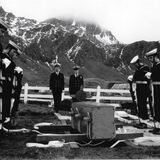
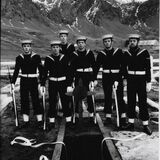
Pictures courtesy of Kevin Rowe who is present in the burial party.
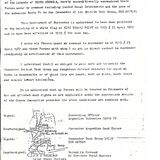
Surrender of document from South Georgia.
SD.
Here is the Board of Inquiry report. https://1drv.ms/b/s!Ane9lOTY5nFrrk-zPuHTBbD_mbj6


Pictures courtesy of Kevin Rowe who is present in the burial party.

Surrender of document from South Georgia.
SD.
Kermit power said:
Whilst the vast majority just reflect almost incomprehensible levels of bravery and frequently complete selflessness, there are some that just make me wonder whether any edict went out to find a suitable recipient as it was perceived by those at the top that it was time for a little bit of a boost to morale?
Of course it's equally possible that some of the citations were just written with an extra couple of levels of famous British understatement and I'm doing the recipients a great disservice.
The Lancashire Fusiliers famously were awarded "six VCs before breakfast" in the Gallipoli Landings. It could be argued that the ballot held afterwards for the final 3 recipients would reinforce this assumption. Of course it's equally possible that some of the citations were just written with an extra couple of levels of famous British understatement and I'm doing the recipients a great disservice.
SD.
OK a shameless bump from me - 38 years ago the country pulled together and faced a threat together with strength, determination, a can-do spirit and humour. Yes there were set backs along the way but we pulled through it together,
Let's hope we can rekindle some of that spirit and get though our present crisis. Today marks the 38th anniversary of the invasion of the Falklands.
SD.
Let's hope we can rekindle some of that spirit and get though our present crisis. Today marks the 38th anniversary of the invasion of the Falklands.
SD.
I think one of the reasons is that the Task Force (including the carriers) were operating so far to the east of the Islands they were jokingly called the West African Navy. There was no UK air to air refueling in theatre (except the huge logistical effort for the Black Buck raids). It is possible that an anti-air destroyer could have been stationed between the Islands and the mainland to engage the C130 but without air cover a ship is very vulnerable to air power.
I've got some friends who served down there and one or two contacts in the Argentine navy at the time. I'll see if I can find a definitive answer.
SD.
I've got some friends who served down there and one or two contacts in the Argentine navy at the time. I'll see if I can find a definitive answer.
SD.
threadlock said:
I've just stumbled onto this thread having absent-mindedly Googled the name of one of the ships of which my dad was the CO. Weird to see it mentioned, with a scary fact about the events that he hasn't mentioned to me before!
Edit: Having re-checked the timeline my dad wasn't CO during the events described in this thread - he was down there on the same ship a couple of years later to patrol. Phew!
OP here, fancy sharing some of the details? If I've got any documents that may be of interest I'll happily share.Edit: Having re-checked the timeline my dad wasn't CO during the events described in this thread - he was down there on the same ship a couple of years later to patrol. Phew!
Edited by threadlock on Friday 12th March 16:30
SD.
edit: - also noted some of the sound recordings from HMS Glasgow are now dead links. I'll see if I can rehost them.
42 years ago the Royal Navy lost it's first warship in combat since WW2.
Later tonight I will be raising a tot to those who are still on patrol.
Roll of Honour - HMS Sheffield.
Petty Officer David R. Briggs, D.S.M.
Catering Assistant Darryl M. Cope
Lieutenant Commander David I. Balfour
Weapons Engineering Artificer Andrew C. Eggington
Sub-Lieutenant Richard C. Emly
Petty Officer Cook Robert Fagan
Cook Neil A. Goodall
Leading Marine Engineering Mechanic Allan J. Knowles
Laundryman Lai Chi Keung
Leading Cook Tony Marshall
Petty Officer Anthony R. Norman
Cook David E. Osborne
Weapons Engineering Artificer Kevin R. F. Sullivan
Cook Andrew C. Swallow
Acting Chief Weapons Mechanic Michael E. G. Till
Weapons Engineering Mechanic Barry J. Wallis
Leading Cook Adrian K. Wellstead
Master-at-Arms Brian Welsh
WEO Lieutenant Commander John S. Woodhead, D.S.C. Read his citation in the London Gazette.
Cook Kevin J. Williams
SD.
Later tonight I will be raising a tot to those who are still on patrol.
Roll of Honour - HMS Sheffield.
Petty Officer David R. Briggs, D.S.M.
Catering Assistant Darryl M. Cope
Lieutenant Commander David I. Balfour
Weapons Engineering Artificer Andrew C. Eggington
Sub-Lieutenant Richard C. Emly
Petty Officer Cook Robert Fagan
Cook Neil A. Goodall
Leading Marine Engineering Mechanic Allan J. Knowles
Laundryman Lai Chi Keung
Leading Cook Tony Marshall
Petty Officer Anthony R. Norman
Cook David E. Osborne
Weapons Engineering Artificer Kevin R. F. Sullivan
Cook Andrew C. Swallow
Acting Chief Weapons Mechanic Michael E. G. Till
Weapons Engineering Mechanic Barry J. Wallis
Leading Cook Adrian K. Wellstead
Master-at-Arms Brian Welsh
WEO Lieutenant Commander John S. Woodhead, D.S.C. Read his citation in the London Gazette.
Cook Kevin J. Williams
SD.
Gassing Station | The Lounge | Top of Page | What's New | My Stuff




